*This article has been updated.
When Dom Phillips was killed alongside Brazilian Indigenous rights expert Bruno Pereira in the Amazon’s Javari Valley on June 5, 2022, the British journalist left an unfinished book behind. For years, he’d been working on “Como Salvar a Amazônia: Perguntem a Quem Sabe” (How to Save the Amazon: Ask Those Who Know).
Three years after the crime, a group of journalist colleagues and friends completed the book in a show of solidarity that transformed the tragedy into a collective project to immortalize the work of Phillips and Pereira to protect the Amazon.
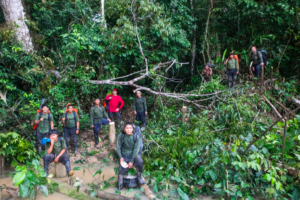
The Funai expedition led by Bruno Periera (top right) which Dom (in red) accompanied
through the Javari Valley tracking the reported sighting of a number of isolated indigenous
people, 2018. Credit: Disclosure / Gary Calton
“I believe that the book has a greater impact today because of the repercussions of the case, which brought attention to the enormous challenges that the forest and its defenders continue to face,” activist Alessandra Sampaio, Phillips’ widow, told LatAm Journalism Review (LJR).
“The title of the book, ‘How to Save the Amazon,’ is disturbing because neither Dom nor Bruno were saved,” she continued. “And Dom himself wrote that the question is not limited to how, but why to save it. It comforts me to know that, despite everything, they were unable to silence him; in fact, they expanded the reach of his message of hope about how to keep the world’s largest rainforest alive.”
The book, published in Brazil and England last week, hits bookstores in the United States on June 10. The team is looking for a publisher to release the book in Spanish.
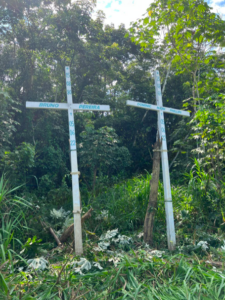
Memorial crosses to Bruno & Dom at site of their murders, Javari Valley. Credit: Jon Watts
According to Brazil’s Federal Police, Phillips and Pereira were shot dead after falling into an ambush while sailing by boat through the Javari Valley region, the second largest Indigenous land in Brazil and home to the largest concentration of isolated peoples in the world.
Police identified nine people as participants in the crime. Their investigation concluded that the murders were a result of the surveillance activities carried out in the region by Pereira, who was active in defending environmental preservation and guaranteeing Indigenous rights.
Before he was murdered, Phillips had not even reached the halfway point of his book. He had drafted a detailed proposal for publication and the introduction, written the first three and a half chapters, and left notes, transcripts and plans—some more detailed than others—for the six chapters that would follow.
The published work includes this material left by Phillips, the six chapters co-authored with collaborating journalists, and a preface and afterword to wrap up the work in light of the author's death.
The afterword is written by Indigenous leader Beto Marubo in partnership with journalist Helena Palmquist. The preface details the crime against Philips and Pereira, outlines the political and environmental events that happened afterward—in addition to the murder, Lula's victory in the elections months later, and the change in the government's environmental policy—and explains how the British man went from being a freelance reporter covering oil to a professional so focused on the Amazon that he took a sabbatical to finish the book on the subject.
“After learning about the outrage that many journalists felt about the case, experiencing with some of them the mobilization to finish Dom’s book was touching,” Sampaio said. “The feeling of solidarity, the respect for all the material that Dom left behind, the altruism, the generosity, it was a very beautiful movement of unity.”
Jonathan Watts, global environment editor of The Guardian and cofounder of Amazon-based journalism site Sumaúma, told LJR the book is a way to honor his friend and strengthen his legacy.
“I think there is a really strong journalistic desire to show solidarity for a fallen comrade, for a fallen colleague, and to show that even if you kill a journalist you cannot silence the story,” he said. “And, in fact, the story will be continued and amplified because that could have been any of us in a way. It happens to too many journalists that are killed because they witness something that people don't want them to see.”
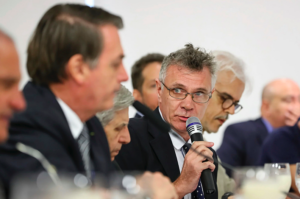
Dom questioning Brazil's far-right president Jair Bolsonaro at the presidential palace in
Brasília. 2019. Credit: Marcos Corrêa/PR
Watts led the group chosen by Sampaio to coordinate the project, which also included Phillips' literary agent, Rebecca Carter; journalist David Davies, a friend from his time working in music journalism in the 1990s; Tom Hennigan, the Irish Times correspondent in São Paulo; and Andrew Fishman, co-founder of Intercept Brasil.
They established the criteria for choosing the journalists who would finish the chapters, in addition to writing the book’s foreword. Watt emphasizes that none of these contributors are listed as authors or will receive royalties — all rights belong to Phillips' literary estate, which is administered by Sampaio. About 20 people, including journalists and experts on the Amazon, as well as Phillips' friends and colleagues, also participated in editing the chapters.
“The big question was how to decide who to do the chapters,” he said. “Should it be the people who knew Dom best or the people who knew the Amazon best? And in the end, we opted for the latter, which is difficult because Dom has other friends who are really amazing journalists and writers. So the hard thing was not finding volunteers, it was choosing which volunteers.”
The main criteria for choosing contributors, Watts said, was who was closest to the subject, knew the history best and had the most experience possible in writing long texts or even books.
For example, he said that journalist Stuart Grudgings wrote the chapter on Costa Rica because he lives in the country and already knew Phillips' intentions for that part of the book. When the British journalist went to the country to see positive examples of rainforest protection, they met and Grudgings clearly knew what Phillips wanted to address. Another example is the chapter on Altamira, in Pará, written by journalist Eliane Brum and which makes the transition between the material left by Phillips and the texts finished by the contributors. She lives in the city and has extensive experience writing journalistic books.
Watts said some chapters, such as the ones on finance, international relations and biopharmaceuticals and the one he wrote to conclude the book, were much more difficult. The material left was much more vague and superficial, and Watts said that according to Phillips' literary agent, even he wasn't sure how he would end the book.
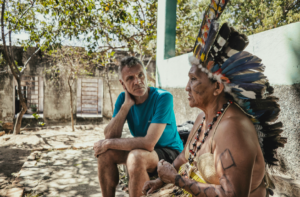
In Raposa Serra Do Sol, interviewing Mariana Tobias of the Macuxi people. Credit: Disclosure / Nicoló Lanfranchi
“I guess the main challenge was how we could stay true to Dom's intentions when we didn't always know what those intentions were,” he said. “We collected together all of the material that he had been using, all of his notes, his photographs, his audio recordings, his chapter plans, his finished chapters.”
“I specifically asked when I wrote to all the contributors, I said, ‘Here's the notes, here's the original plans that Dom had. Use those. Try to trace his footsteps,’” he continued. “It's a kind of a riddle, a mystery in a way. You need to follow his footsteps, talk to the people he spoke to, look at the solutions he was interested in. Assess them. And then not so much try to think like Dom, but try to engage in a dialogue with what you knew of Dom, your memories of Dom. And engage in that in your mind and with his notes. Have that discussion in your head about him. And in that way, trying to keep Dom present in the book.”
Tom Phillips, the Guardian’s Latin America correspondent and a near-namesake of the murdered journalist, was chosen to write the chapter on Indigenous defenders. His selection was no coincidence — in addition to his knowledge of the region, he had worked closely with Dom Phillips between 2018 and 2022, during the years of President Jair Bolsonaro, and has also written extensively about the Yanomami Indigenous territory, which became part of the chapter’s focus.
“I think for me, something that helped me a great deal was the fact that I had worked very closely with Dom,” he told LJR. “So we spoke for many many hours about Brazil, we wrote many many stories together, I edited many of his pieces. So I had a good idea of you know how Dom saw things, how Dom wrote, how he reported and we had also both done independently and at different moments quite a lot of reporting on the Yanomami Indigenous territory.”
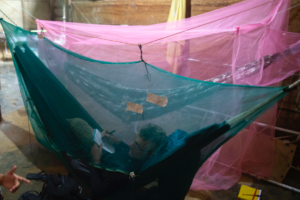
Dom on the road in Yanomami indigenous territory with his ever-present notebook, 2019. Credit: Disclosure / João Laet
Tom Phillips’ writing process involved combining the reporting that Dom Phillips did in the Yanomami region in 2019, when he was one of the only foreign journalists to cover the beginning of the invasion of thousands of miners into the area, with his own investigation that Dom was unable to continue reporting. The great challenge, he said, was precisely the difficulty mentioned by Watts: remaining faithful to Dom Phillips’ intentions without exactly knowing all of his plans.
“I think the main editorial challenge was trying to get the tone and the voice right,” he said. “It's quite sad to talk about because everybody always found our joint byline quite amusing, Tom Phillips and Dom Phillips, Dom Phillips and Tom Phillips. And there were many of those bylines over the years. And this book is, I suspect, my chapter in this book with Dom is our last joint byline, the Dom and Tom byline.”
Writing about Indigenous defenders also has an extra special meaning for Tom Phillips. During the ten-day search for Dom Phillips and Pereira in 2022, he witnessed the work of these Indigenous activists and how committed they were to finding the two.
“I saw with my own eyes the absolutely incredible grit, resilience and determination of the Indigenous Defenders, from the Indigenous activists from the monitoring team at Univaja [Union of Indigenous Peoples of the Javari Valley],” he said. “They absolutely threw themselves into this extraordinarily difficult attempt to find Dom and Bruno in the Javari region.”
“I think these Indigenous monitoring teams are an absolutely essential part of the answer to the question that Dom posed in his book,” he continued. “And I was really, really thrilled that that was something that I could write about in this chapter. I know it was something that was close to Dom's heart, too.”
*This article has been updated to include that David Davies was a music journalist with Phillips in the 1990s, not late 1960s.